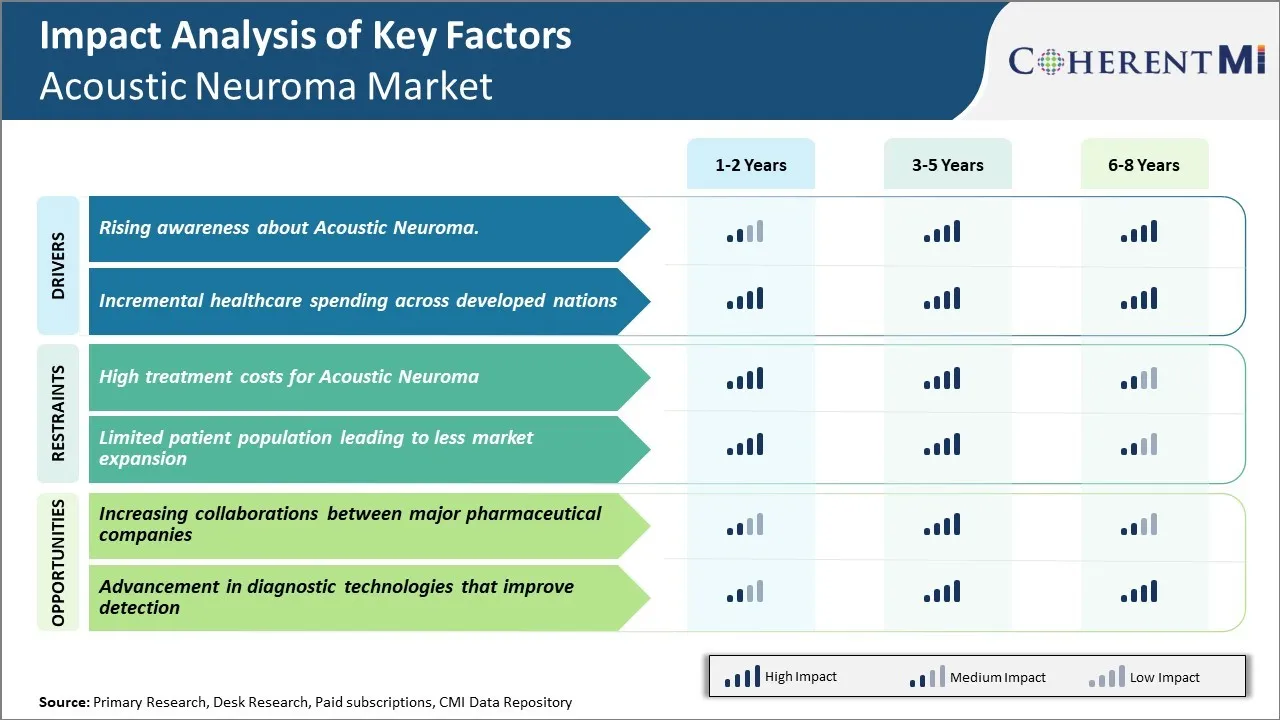声学神经元市场 规模与份额分析 - 成长趋势与预测 (2024 - 2031)
声学神经元市场按诊断(成像技术、声学、电子物理学)、治疗(观察、外科、辐射治疗)、地理(北美、拉丁美洲、亚太、欧洲、中东和非洲)分类。 报告提供了上述价值(10亿美元)。....
声学神经元市场 趋势
市场驱动器 - 提高对声学神经元的认识.
由于诊断检测能力先进,医师对声神经瘤等病情的认识不断提高,今天发现的病例比以往任何时候都多. 传统上被认为是一个罕见的条件,现在人们广泛承认,它可能不像以前的想法那么罕见.
倡导团体和癌症组织针对颅神经疾病开展的越来越多的公共卫生运动在提高公众对这一良性肿瘤的认识方面也发挥了关键作用。 由于长期担心不明原因,患者不再将自己的症状包起来,而是在出现早期症状时迅速寻求医疗帮助,如失聪、锡尼图斯或平衡问题。
这使得在肿瘤体积仍然很小,而且通过最低侵入性程序极易治疗时,能够及早检测。 随着及时诊断和干预,保持面部神经功能和防止其他并发症的机会也更高. 公众对改善获得检查和诊断服务的需求正在增加。
更多患者希望彻底调查单方面听力丧失或神经问题背后的原因,而不是常规测试. 所有这些因素都表明,社会意识得到提高,而社会意识正成为有助于发现声神经瘤病例增长的重要动力。
市场驱动力 -- -- 发达国家保健支出递增
世界各地的发达国家年复一年地投入更多的预算拨款,用于其公共卫生基础设施的现代化和卫生技术进步。 各国政府正在大量投资于最新的诊断和治疗技术、医疗设施升级、扩大保险覆盖面和加强初级保健网络。
不断增加的保健支出满足了对先进设备的需求,并增加了诊断/手术程序。 由于选择有限和费用高昂而一度被认为无法处理或难以解决的条件的处理,现在以较低的成本和风险变得容易处理。
特别是神经外科在技术先进的工具、资源和熟练劳动力的推动下取得了巨大进展。 侵入性最小的内窥技术正在迅速取代常规的开放式手术,从而缩短了住院时间和病人的恢复时间。 这使得良性脑和头骨基瘤的管理更加方便.
与此同时,公共/私营保健系统的大宗采购协议确保了资金的正常流动,用于采购新的医疗设备,包括核磁共振扫描仪,提供对诊断诸如声神经瘤等肿瘤至关重要的高分辨率成像。
保险良好的人口具有广泛的购买力,在不面临财政困难的情况下采取昂贵但改变生命的医疗干预措施。

市场挑战 -- -- 低声神经素的高处理成本
声神经瘤市场面临的主要挑战之一是与病情管理相关的高治疗成本. 声神经瘤(英語:Acoustic neuroma)是一种罕见的无脑肿瘤,在第八颅神经上发育,将内耳与大脑连接起来.
虽然外科切除声神经瘤是主要的治疗方法,但由于涉及微妙的神经外科手术,手术程序非常复杂和昂贵. 在美国,去除声神经瘤的微手术通常花费在5万至15万美元之间,而不计入与住院、药物和康复有关的额外费用。
对于需要多次手术或额外治疗的患者,如质子束辐射疗法或立体放射外科,其费用会进一步扩大,平均每届费用为5万至10万美元. 由于与管理这种罕见状况有关的高价格标签,在没有充分保险或补贴的情况下,病人获得治疗的机会受到严重限制。 这一财政负担对全球声神经瘤的市场增长构成重大挑战。
市场机会 -- -- 加强主要制药公司之间的合作
声神经瘤市场正在探索的机会之一是加强主要制药公司之间的合作。 由于无主药物状况和很少发生声神经瘤,个别公司不愿对与药物开发有关的研发活动进行大量投资。
然而,大型制药商目前正在与生物技术初创企业和学术研究中心合作,以分担研究药物疗法等较新的治疗办法的风险和费用。 例如,诺华公司与学术研究人员合作调查潜在的药物目标。
同样,辉瑞公司还与生物技术开发基因治疗机构持续合作。 这种联盟有助于加快临床试验,使费用大大低于单独努力。 随着更多制药巨头进入以声神经瘤为重点的伙伴关系,这将在未来几年推动创新和提供手术以外的扩大治疗方案。 这为总体市场增长提供了有利可图的机会。